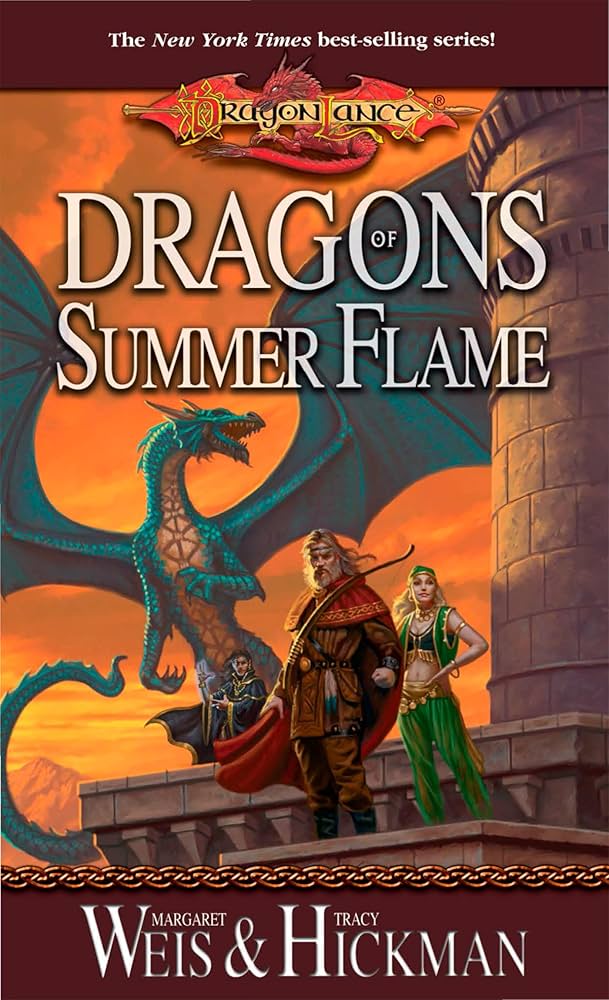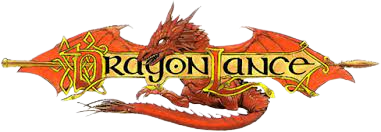Dragons of Summer Flame

Table of Contents
ToggleOverview
Dragons of Summer Flame is the direct continuation of both the Chronicles and Legends series. It introduces a new generation of heroes, especially the children of the original companions, while bringing back iconic figures like Caramon, Tasslehoff, Dalamar, and Raistlin (in a limited but critical way).
It also features the most cosmic conflict yet faced in Krynn: the return of Chaos, the Father of All and Nothing—a primal force beyond the gods, bent on unmaking the world. This is the novel where everything changes—gods fall, magic collapses, and the Age of Mortals begins.
Main Characters
New Generation
- Palin Majere – Son of Caramon, a White Robe mage, and Raistlin’s nephew. Struggles to define himself outside his uncle’s shadow.
- Steel Brightblade – Son of Sturm and Kitiara. A Knight of Takhisis trying to forge a path of honor in a twisted order.
- Usha Majere – A mysterious girl raised by mystics, possibly the daughter of Chaos himself.
- Tanin and Sturm Majere (Jr.) – Caramon’s older sons. Brave and loyal, though their arcs are tragically short-lived.
Returning Characters
- Caramon Majere – Now an aging innkeeper, watching his children step into a dangerous world.
- Tasslehoff Burrfoot – As mischievous and loyal as ever—somehow defying death itself to play a crucial role in fate.
- Dalamar – Raistlin’s former apprentice and a powerful Black Robe mage, walking a treacherous line.
- Raistlin Majere – Appears briefly in spectral form, offering wisdom from beyond.
- The Gods of Krynn – Particularly Takhisis, who plays a devastating long game in the background.
Plot Summary
Prelude: A World on Edge
The peace following the War of the Lance has fractured. The Knights of Takhisis are rising as a powerful new force, and Palin Majere is preparing to take the Test of High Sorcery—but something is wrong with magic itself.
Meanwhile, the enigmatic Usha arrives with a dire warning from the Mystics of the Irda, the reclusive and ancient race of spellcasters once known as ogres in their original, beautiful form.
The Irda and the Graygem
Usha reveals that the Irda have shattered the Graygem of Gargath, the ancient artifact that once imprisoned Chaos. This catastrophic event releases Chaos himself, a godlike entity who seeks to unmake Krynn, seeing it as a flawed experiment of the other gods.
“Chaos is not evil. He is worse—he is beyond good and evil. He is destruction given form.”
The Chaos War Begins
The Knights of Takhisis, Solamnic Knights, mages, dragons, and even gods scramble to prepare. But Chaos is not an army—they are a force of entropy. Strange monsters emerge. Reality breaks. Magic begins to fail.
Palin, Usha, and Steel become central figures in this unraveling.
- Palin becomes the last true wizard of the old orders.
- Usha may be Chaos’s child—but chooses free will.
- Steel seeks redemption, torn between honor and loyalty.
The Battle of Chaos
In an apocalyptic confrontation, mortals and gods alike confront Chaos in a final battle. Tasslehoff (who is not supposed to be there—literally having traveled past his own death) becomes a key player in defeating Chaos—not with force, but by doing the unexpected.
The gods, faced with their inability to contain Chaos, make a bargain: they will leave Krynn entirely, taking divine magic and guidance with them.
And so ends the Age of Despair—and begins the Age of Mortals.
Key Events & Turning Points
- The deaths of Tanin and Sturm Majere (Jr.) in battle—marking the fragility of the new generation.
- Palin’s Test and transformation into the bearer of the Staff of Magius, and the burden of legacy.
- Steel’s noble sacrifice, defying his order to stand for what’s right.
- The gods’ withdrawal, leaving mortals alone for the first time in known history.
- The collapse of traditional magic, giving way to mysticism and primal sorcery.
Themes
- Legacy and Inheritance – Every major character struggles with the weight of their parents’ choices and reputations.
- Chaos vs. Order – Not just as good vs. evil, but as cosmic balance. What happens when law fails and meaning breaks down?
- Faith Without Gods – What do mortals believe in when divine guidance disappears?
- Free Will and Choice – Usha and Steel especially wrestle with nature vs. choice, proving identity is not destiny.
- The End of an Age – This is a book of transitions. Everything familiar—magic, religion, politics—breaks.
Tone & Style
- Epic and mythic – The story moves from personal arcs to world-altering events.
- Emotionally powerful – Deaths are permanent, choices have consequences, and good people fail.
- Poetic and philosophical – Especially in the latter chapters, as gods speak and Chaos confronts the world.
This book reads like the book of Revelations for Krynn—an ending and a beginning, full of loss, awe, and redefinition.
Reception
Dragons of Summer Flame is divisive but essential in the Dragonlance canon.
Praise:
- Bold, ambitious storytelling
- Deep, emotional character arcs (Palin, Steel, Usha)
- Huge impact on the world’s lore
- A proper “passing of the torch” to the next generation
Criticism:
- Tragic tone; many fan favorites die or are changed forever
- Some readers miss the “classic” adventure feel
- The shift to the Age of Mortals was controversial at the time
Still, most agree: it’s required reading to understand what comes next.
Final Thoughts
Dragons of Summer Flame is the culmination of everything that came before and the threshold to everything that follows. It’s bold, tragic, mythic, and unforgettable—a fantasy of endings, where even the gods must step aside and let mortals choose their fate.
Perfect for:
- Fans of Raistlin, the Majere family, and moral complexity
- Readers who love apocalyptic stakes and deep character conflict
- Anyone ready to see the world of Krynn transformed
